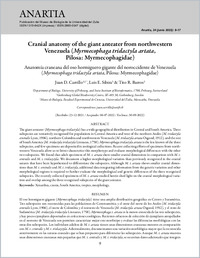Cranial anatomy of the giant anteater from northwestern Venezuela (Myrmecophaga tridactyla artata, Pilosa: Myrmecophagidae)
DOKPE
- Carrillo, Juan D. ORCID University of Fribourg
- Sibira, Luis E. Universidad de Zulia
- Barros, Tito R. Universidad de Zulia
- 30.09.2022
Published in:
- Anartia : Publicación del Museo de Biología de la Universidad del Zulia. - Universidad del Zulia. - 2022, vol. 34, p. 9-17
English
Spanish
The giant anteater (Myrmecophaga tridactyla) has a wide geographical distribution in Central and South America. Three subspecies are tentatively recognized for populations in Central America and west of the northern Andes (M. tridactyla centralis Lyon, 1906), northern Colombia and northwestern Venezuela (M. tridactyla artata Osgood, 1912), and the rest of South America (M. tridactyla tridactyla Linnaeus, 1758). Myrmecophaga tridactyla artata is the less known of the three subspecies, and few specimens are deposited in zoological collections. Recent collecting efforts of specimens from northwestern Venezuela allow us to better characterize this morphotype and evaluate morphological differences with the other two subspecies. We found that adult specimens of M. t. artata show smaller cranial dimensions in comparison with M. t.
centralis and M. t. tridacytyla. We document a higher morphological variation than previously recognized in the cranial sutures that have been hypothesized to differentiate the subspecies. Although M. t. artata shows smaller cranial dimensions than M. t. centralis and M. t. tridactyla, additional data integrating information from the genetic variation and other morphological regions is required to further evaluate the morphological and genetic differences of the three recognized subspecies. The recently collected specimens of M. t. artata studied herein shed light on the cranial morphological variation and overlap among the three recognized subspecies of the giant anteater. El oso hormiguero gigante (Myrmecophaga tridactyla) tiene una amplia distribución geográfica en Centro y Suramérica. Tres subespecies son reconocidas para las poblaciones de Centroamérica y el oeste del norte de los Andes (M. tridactyla centralis Lyon, 1906), el norte de Colombia y el noroeste de Venezuela (M. tridactyla artata Osgood, 1912), y el resto de Sudamérica (M. tridactyla tridactyla Linnaeus, 1758). Myrmecophaga t. artata es la menos conocida de las tres subespecies, y hay pocos ejemplares depositados en colecciones zoológicas. Recientes esfuerzos de colección de ejemplares atropellados en el noroeste de Venezuela nos permiten caracterizar mejor este morfotipo y evaluar las diferencias morfológicas con las otras dos subespecies. Los individuos adultos de M. t. artata tienen unas dimensiones craneanas menores en comparación con M. t. centralis y M. t. tridacytyla. Adicionalmente, documentamos una variación morfológica mayor que la reconocida anteriormente en las suturas craneales que se han propuesto para diferenciar las subespecies. Aunque M. t. artata muestra
unas dimensiones craneanas más pequeñas que M. t. centralis y M. t. tridactyla, se necesitan datos adicionales que integren la información de la variación genética y de otras regiones morfológicas para evaluar más a fondo las diferencias morfológicas y genéticas de las tres subespecies reconocidas. Los ejemplares de M. t. artata recientemente recolectados y estudiados aportan nueva información sobre la variación de la anatomía craneana entre las tres subespecies reconocidas del oso hormiguero gigante.
centralis and M. t. tridacytyla. We document a higher morphological variation than previously recognized in the cranial sutures that have been hypothesized to differentiate the subspecies. Although M. t. artata shows smaller cranial dimensions than M. t. centralis and M. t. tridactyla, additional data integrating information from the genetic variation and other morphological regions is required to further evaluate the morphological and genetic differences of the three recognized subspecies. The recently collected specimens of M. t. artata studied herein shed light on the cranial morphological variation and overlap among the three recognized subspecies of the giant anteater. El oso hormiguero gigante (Myrmecophaga tridactyla) tiene una amplia distribución geográfica en Centro y Suramérica. Tres subespecies son reconocidas para las poblaciones de Centroamérica y el oeste del norte de los Andes (M. tridactyla centralis Lyon, 1906), el norte de Colombia y el noroeste de Venezuela (M. tridactyla artata Osgood, 1912), y el resto de Sudamérica (M. tridactyla tridactyla Linnaeus, 1758). Myrmecophaga t. artata es la menos conocida de las tres subespecies, y hay pocos ejemplares depositados en colecciones zoológicas. Recientes esfuerzos de colección de ejemplares atropellados en el noroeste de Venezuela nos permiten caracterizar mejor este morfotipo y evaluar las diferencias morfológicas con las otras dos subespecies. Los individuos adultos de M. t. artata tienen unas dimensiones craneanas menores en comparación con M. t. centralis y M. t. tridacytyla. Adicionalmente, documentamos una variación morfológica mayor que la reconocida anteriormente en las suturas craneales que se han propuesto para diferenciar las subespecies. Aunque M. t. artata muestra
unas dimensiones craneanas más pequeñas que M. t. centralis y M. t. tridactyla, se necesitan datos adicionales que integren la información de la variación genética y de otras regiones morfológicas para evaluar más a fondo las diferencias morfológicas y genéticas de las tres subespecies reconocidas. Los ejemplares de M. t. artata recientemente recolectados y estudiados aportan nueva información sobre la variación de la anatomía craneana entre las tres subespecies reconocidas del oso hormiguero gigante.
- Faculty
- Faculté des sciences et de médecine
- Department
- Département de Biologie
- Language
-
- English
- Classification
- Biological sciences
- License
- License undefined
- Open access status
- green
- Identifiers
-
- DOI 10.5281/zenodo.7131289
- ISSN 1315-642X
- ISSN 2665-0347
- Persistent URL
- https://folia.unifr.ch/unifr/documents/324721
Statistics
Document views: 130
File downloads:
- carrilloetal.-2022-cranialanatomyofthegiantanteaterfromnorthwe.pdf: 163
